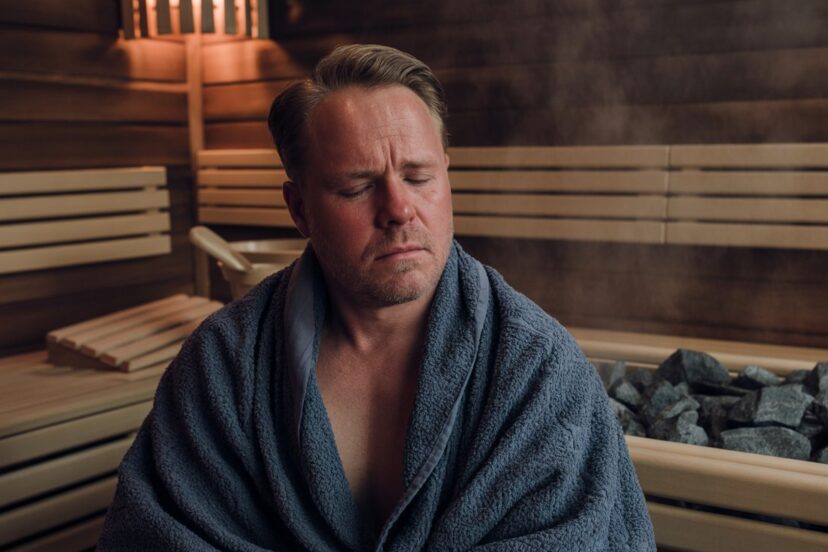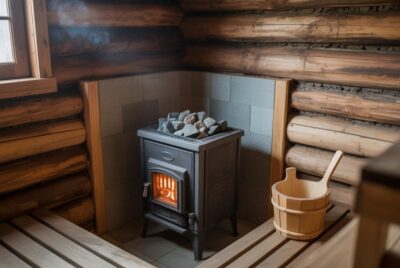Should You Use a Sauna When Sick?
*We may earn a commission for purchases made using our links. Please see our disclosure to learn more.
The first time I caught a terrible cold after installing my home sauna was a confusing experience. There I was, congested and miserable, looking longingly at my cedar sanctuary in the corner of the basement. I’d invested in this beautiful Finnish-style sauna just three months prior, falling in love with the post-workout relaxation and stress relief it provided. But now, with a stuffy nose and scratchy throat, I found myself wondering: Is using a sauna when sick a brilliant recovery technique or a dangerous mistake?
Like many of you reading this, I turned to the internet for answers. What I found was a confusing mix of contradictory advice. Some sources warned against any heat exposure while ill, while others claimed saunas were miracle cures for everything from the common cold to more serious conditions.
What I’ve learned through personal experience, research, and consulting with healthcare professionals is that the answer isn’t black and white. The relationship between sauna when sick scenarios and actual health outcomes is nuanced, personal, and worthy of deeper exploration.
Key Takeaways
- Using a sauna while sick depends on your specific illness and symptoms
- Saunas may help with congestion and some cold symptoms but can be dangerous with fevers
- Proper hydration is essential when using a sauna during illness
- Always listen to your body and consult healthcare professionals when in doubt
- Sauna use for illness should be moderate and mindful of your energy levels
“Heat therapy has been used for centuries as a healing modality. When applied appropriately, sauna use can support the body’s natural recovery processes.”
— Dr. Rhonda Patrick, FoundMyFitness
The Sauna-Sick Connection: My Personal Discovery
My journey into using saunas during illness began with cautious experimentation. After researching the potential benefits and risks of using a sauna when sick, I decided to try a gentle session during a minor head cold. The experience was transformative—the congestion that had been plaguing me for days eased significantly after just 15 minutes in the gentle heat.
But this wasn’t always the case. When I made the mistake of using my sauna during a feverish flu, I quickly learned that heat therapy isn’t a one-size-fits-all solution. The experience left me dizzy, dehydrated, and with my symptoms worsened rather than improved.
These contrasting experiences taught me something valuable: context matters enormously when considering a sauna when sick, and listening to your body is key.
When Saunas Can Help: Finding Relief Through Heat
Congestion and Respiratory Symptoms
One of the most noticeable benefits I’ve experienced is how sauna heat can help ease congestion. The warm, humid air works similarly to a steam shower, helping to:
- Loosen mucus in nasal passages
- Reduce inflammation in airways
- Promote easier breathing
- Provide temporary relief from sinus pressure
The first time I experienced this relief was during a stubborn cold that had left me congested for nearly a week. After a gentle 10-minute sauna session (at a lower temperature than my usual preference), I could finally breathe through my nose again. The relief wasn’t permanent, but it provided a welcome respite from the constant stuffiness.
Muscle Aches and Joint Pain
Many illnesses come with body aches that can make recovery miserable. I’ve found that brief sauna sessions can help:
- Relax tense muscles
- Reduce joint stiffness
- Increase blood circulation to painful areas
- Trigger the release of endorphins (natural pain relievers)
During one particularly achy bout with a seasonal cold, the gentle heat of my sauna provided more comfort than over-the-counter pain relievers. The full-body warmth seemed to penetrate deep into my sore muscles, providing relief that lasted for several hours afterward.
Stress Reduction and Sleep Improvement
Being sick is stressful, and stress can further suppress immune function. Saunas can help break this cycle by:
- Lowering cortisol levels (the stress hormone)
- Promoting relaxation and mental calm
- Preparing your body for deeper sleep
- Creating a quiet sanctuary away from daily pressures
I’ve lost count of how many times I’ve emerged from a gentle sauna session feeling mentally refreshed even when physically under the weather. This psychological boost shouldn’t be underestimated in the healing process.
When to Avoid the Sauna: Lessons Learned the Hard Way
Fever: My Cautionary Tale
Perhaps my most important lesson came when I decided to “sweat out” a fever in my sauna. This folk remedy, passed down through generations, seemed logical enough—until I tried it.
Within minutes of entering the heated room, I felt dizzy and nauseous. My heart was racing uncomfortably, and I quickly realized I was making a dangerous mistake. When you have a fever, your body is already working to regulate its temperature. Adding external heat can:
- Further elevate your core temperature to potentially dangerous levels
- Increase dehydration risk
- Put additional strain on your cardiovascular system
- Potentially lead to fainting or heat exhaustion
I learned that when your body is fighting a fever, it needs support—not additional challenges. This experience taught me to respect the body’s natural healing processes rather than trying to force them.
Severe Dehydration and Vomiting Illnesses
Another hard-learned lesson came during a stomach bug that had left me vomiting and unable to keep fluids down. In my misguided hope that sauna heat might kill whatever virus was plaguing me, I attempted a short session.
The result was predictable in hindsight: increased nausea, dizziness, and a worsening of all symptoms. When you’re already struggling with hydration, the intense sweating induced by sauna use can quickly push you into dangerous territory.
Finding Balance: My Practical Approach to Sauna Use While Sick
Through years of experimentation and learning, I’ve developed some personal guidelines that help me decide when and how to use the sauna during illness:
Listen to Your Body’s Signals
The most important lesson I’ve learned is to tune in to what my body is telling me. Some signs that indicate sauna use might be beneficial include:
- Mild congestion without fever
- Slight muscle aches without extreme fatigue
- Mental stress related to being ill
- Feeling cold but not feverish
Conversely, signs that warn against sauna use include:
- Any fever, even low-grade
- Extreme fatigue or weakness
- Dizziness or lightheadedness
- Active dehydration symptoms
- Skin infections or open wounds
Modify Your Sauna Routine
When I do use the sauna while mildly ill, I make significant adjustments to my normal routine:
- Shorter sessions (usually 5-10 minutes instead of my typical 20-30)
- Lower temperatures (120-130°F instead of my usual 170-180°F)
- More frequent hydration breaks
- Having someone nearby or informed about my sauna use
These modifications have allowed me to gain some benefits from heat therapy without overtaxing my already-stressed body.
Hydration Is Non-Negotiable
Perhaps the most critical factor in safe sauna use while sick is hydration. I’ve learned to:
- Drink at least 16-24 ounces of water before entering
- Keep water with electrolytes easily accessible during the session
- Consume another 16-24 ounces immediately afterward
- Monitor urine color as an indicator of hydration status
When sick, our bodies often need more fluids than usual. The additional water loss through sauna sweating means hydration becomes absolutely essential.
The Science Behind Sauna Use During Illness
My personal experiences led me to research the scientific mechanisms behind how saunas interact with our immune systems. What I discovered helped explain both the benefits and risks I’d experienced firsthand.
Heat Shock Proteins and Immune Function
When our bodies experience the controlled stress of sauna heat, they produce heat shock proteins that can:
- Help regulate inflammation
- Enhance certain immune cell functions
- Protect cells from various types of stress
- Support overall resilience
This cellular response explains why some people (myself included) report fewer illnesses after beginning regular sauna practice. However, timing matters—these protective effects work best as preventative measures rather than treatments during active infection.
Blood Flow and White Blood Cell Mobilization
The increased blood circulation during sauna bathing can temporarily boost white blood cell activity. This improved circulation might help:
- Deliver immune cells more efficiently to infection sites
- Remove waste products from inflamed tissues
- Support the body’s natural detoxification processes
- Enhance oxygen delivery throughout the body
I’ve noticed that minor illnesses sometimes seem to resolve more quickly when I incorporate gentle sauna sessions—particularly those annoying colds that linger for weeks.
The Fever Misconception
One dangerous myth I once believed was that saunas could help “burn out” infections by creating an artificial fever. Research has shown this isn’t how our immune systems work. Natural fevers are controlled, systemic responses that include many more mechanisms than simply raising temperature.
Attempting to create an artificial “fever” through external heat:
- Doesn’t trigger the same immune responses
- Can interfere with the body’s natural temperature regulation
- May actually suppress certain immune functions
- Could potentially worsen the infection by stressing the body
This scientific understanding confirmed what my body had already told me through that miserable experience of trying to “sweat out” a fever.
Cultural Perspectives on Heat Therapy During Illness
My own Baltic heritage gave me a cultural connection to sauna use that influenced my approach to health. Many traditional cultures incorporate heat therapy during illness, including:
Finnish Sauna Traditions
In Finland, where saunas are considered essential to wellbeing, there’s a saying: “If sauna, tar, and vodka don’t help, the illness is fatal.” While I don’t endorse this comprehensive approach (especially the vodka part!), Finnish cultural wisdom does include important nuances about when sauna use is appropriate during illness.
The Finnish approach typically advises:
- Avoiding sauna with high fevers
- Using gentler temperatures when not feeling well
- Following sauna with cooling (but not shocking) temperature exposure
- Prioritizing rest and recovery after the sauna session
Native American Sweat Lodge Practices
Many Indigenous North American healing traditions incorporate sweat lodges as purification and healing ceremonies. These practices often emphasize:
- The spiritual and emotional components of healing
- Community support during illness
- Intentional use of heat as part of a holistic approach
- Ceremonial aspects that promote mental wellness alongside physical recovery
While my home sauna lacks the rich cultural context of a sweat lodge ceremony, I’ve found that approaching sauna use mindfully—with intention for healing rather than just habit—enhances its therapeutic potential.
My Evolution in Sauna Use Through Different Illnesses
Through trial and error, I’ve developed different approaches to sauna use depending on the specific illness I’m experiencing. Here’s what I’ve learned works for me:
Head Colds and Congestion
When dealing with the stuffy nose and sinus pressure of a head cold:
- Brief (5-10 minute) sauna sessions provide significant congestion relief
- Adding eucalyptus oil to water for steam enhances the decongestant effect
- Gentle face massage during heat exposure helps drain sinuses
- Following with cool (not cold) water nasal rinses extends the benefits
These gentle sessions have become my go-to remedy for congestion, often providing hours of easier breathing after just a short heat exposure.
Bronchial Conditions
With deeper chest congestion or coughs:
- Slightly longer sessions (10-15 minutes) at moderate temperatures
- Focus on deep, slow breathing to get warm air into the lungs
- Using a sauna bench at a lower level where air is less hot but more humid
- Following with gentle chest percussion to help loosen mucus
I’ve found this approach particularly helpful for those annoying post-cold coughs that seem to linger for weeks after other symptoms resolve.
Mild Body Aches and Pains
For the general malaise and soreness that accompanies many minor illnesses:
- Medium-length sessions (15 minutes) with occasional cool breaks
- Gentle stretching in the heated environment to ease muscle tension
- Focusing heat exposure on particularly sore areas
- Following with gentle self-massage using cooling peppermint oil
The contrast between heat and cooling afterward seems to reset my pain perception and provide longer-lasting relief than heat alone.
Common Sauna Mistakes I’ve Made While Sick
Looking back at my sauna journey, I recognize several mistakes that taught me valuable lessons:
Mistake #1: Pushing Through Exhaustion
Early on, I sometimes forced myself into the sauna when feeling utterly depleted, believing the “no pain, no gain” mentality applied to recovery. I quickly learned that sauna use requires energy from the body. When you’re sick, that energy might be better used for healing.
Now I use a simple test: if walking up a flight of stairs feels challenging due to illness, it’s not the right time for a sauna session.
Mistake #2: Inadequate Hydration
Despite knowing better, I’ve occasionally entered the sauna without proper hydration when sick. The results were always the same: increased symptoms, dizziness, and prolonged recovery time.
I now treat hydration as a prerequisite, not an option. If I can’t drink enough before a session due to nausea or other symptoms, I skip the sauna entirely.
Mistake #3: Temperature Extremes
In my early sauna days, I maintained my usual high-temperature preference even when ill. I’ve since learned that gentler heat provides most of the benefits while putting much less stress on an already-taxed body.
My “sick sauna” temperature is now at least 30-40 degrees lower than my wellness routine.
Mistake #4: Ignoring Warning Signs
Perhaps most dangerously, I sometimes ignored my body’s signals to leave the sauna, pushing for a few more minutes despite feeling lightheaded or uncomfortable.
Now I exit immediately at the first sign of distress, recognizing that my body’s communication becomes even more important during illness.
Creating Your Own Sauna Recovery Protocol
Based on my experiences and research, here’s my suggestion for developing your personal approach to using saunas during illness:
Step 1: Assess Your Condition Honestly
Before considering sauna use while sick, ask yourself:
- Do I have a fever of any kind? (If yes, avoid sauna use entirely)
- Am I able to stay properly hydrated? (If no, avoid sauna use)
- How is my energy level? (If extremely low, save that energy for healing)
- What specific symptoms am I experiencing? (Certain symptoms benefit more than others)
- Have I consulted healthcare professionals about my condition? (Always advisable for anything beyond minor illness)
This honest assessment is your first and most important safety check.
Step 2: Start Conservatively
If you decide to try sauna use during a mild illness:
- Begin with just 5 minutes at a lower temperature than usual
- Have someone nearby or check in with someone before and after
- Keep expectations realistic—you’re supporting your body, not forcing a cure
- Be prepared to exit immediately if you feel worse
- Follow with rest rather than activity
These conservative guidelines allow you to gauge your body’s response without risking setbacks.
Step 3: Document Your Results
I keep a simple journal of my sauna experiences during illness, noting:
- Symptoms before and after
- Duration and temperature used
- Hydration levels and what I consumed
- Overall energy and recovery impact
- Sleep quality following the session
This documentation has helped me identify patterns in what works for my body, which may differ from yours.
The Emotional Side of Sauna Recovery
Something often overlooked in discussions about saunas and illness is the emotional and psychological component. When sick, we often feel:
- Frustrated by physical limitations
- Anxious about recovery time
- Disconnected from normal wellness routines
- Mentally foggy or depressed
I’ve found that appropriate sauna use can provide psychological benefits during illness that extend beyond physical symptom relief:
- Creating a sense of agency in the healing process
- Providing a familiar wellness routine when other activities are impossible
- Offering quiet reflection time away from screens and stimulation
- Marking a transition point between feeling ill and returning to health
This psychological boost shouldn’t be underestimated in its contribution to overall recovery.
Integrating Sauna Use Into a Holistic Recovery Plan
While I’ve focused on sauna use, it’s important to view heat therapy as just one component of a comprehensive approach to illness recovery. My most successful healing experiences combine:
Nutrition Support
When sick, I prioritize:
- Clear broths and soups that hydrate while providing nutrients
- Anti-inflammatory foods like ginger, turmeric, and berries
- Easily digestible meals that don’t tax the digestive system
- Avoiding alcohol and excessive caffeine, which can worsen dehydration
These dietary choices complement the sauna’s effects by supporting internal healing processes.
Rest Optimization
Proper rest becomes even more crucial when incorporating sauna use while sick:
- Planning sauna sessions during energy peaks, not valleys
- Following sauna use with dedicated rest periods
- Creating optimal sleep conditions (cool room, minimal light exposure)
- Using gentle stretching rather than exercise during recovery
The sauna session itself should feel restorative, not depleting—if it doesn’t, more rest is needed before heat therapy.
Stress Management
Reducing stress supports immune function, making recovery more efficient:
- Brief meditation in or after the sauna
- Limiting exposure to work and news during illness
- Using gentle breathing techniques during heat exposure
- Setting realistic expectations for recovery timelines
The quiet environment of the sauna provides an ideal setting for these stress-reduction practices.
Looking Forward: My Evolving Relationship With Sauna Recovery
As I continue my wellness journey, my approach to sauna use during illness continues to evolve. What I’ve learned most importantly is that there is no universal answer to whether saunas help or harm during sickness—the answer depends entirely on:
- The specific illness and symptoms
- Individual tolerance and experience
- Proper modification of normal sauna routines
- Listening to your body’s unique signals
My future explorations will likely include more research into the timing of sauna sessions during illness progression, as I’ve noticed that the same protocol can have different effects depending on whether I’m in the early, middle, or recovery phase of an illness.
Conclusion: Heat as Helper, Not Healer
Through personal experience, research, and countless conversations with other sauna enthusiasts and health professionals, I’ve come to view sauna use during illness as a potential helper—not a healer.
When approached mindfully, with proper precautions and realistic expectations, sauna sessions can provide symptomatic relief, comfort, and psychological support during certain types of illness. However, they should never replace medical care, adequate rest, or proper hydration.
The most important lesson I’ve learned is the value of personalization. Your body’s response to heat during illness will be unique to you, influenced by the specific condition, your overall health, and your sauna experience level.
By sharing my journey, I hope to encourage not a specific protocol but a thoughtful approach—one that respects both the potential benefits of heat therapy and the body’s need for appropriate support during healing. Whether your sauna becomes a recovery ally or remains unused during illness should ultimately be determined by careful self-assessment, medical guidance when appropriate, and above all, listening to the wisdom of your own body.
Frequently Asked Questions
1. Is it safe to use a sauna when I have a fever?
No, using a sauna with a fever is not safe and could be dangerous. When you have a fever, your body is already working to regulate its temperature. Adding external heat can further elevate your core temperature to potentially dangerous levels, increase dehydration risk, and put additional strain on your cardiovascular system. Always avoid sauna use when experiencing any fever.
2. How long should I stay in a sauna when I’m recovering from a cold?
When recovering from a cold without fever, limit sauna sessions to 5-10 minutes at lower temperatures than you would normally use (around 120-130°F instead of higher temperatures). This shorter duration provides potential benefits for congestion relief without overtaxing your body during recovery. Always exit immediately if you feel dizzy, overly fatigued, or uncomfortable.
3. Can sauna use help boost my immune system?
Regular sauna use may support immune function through several mechanisms, including the production of heat shock proteins and improved circulation. However, these effects work best as preventative measures rather than treatments during active infection. The stress of high heat during an active infection could potentially burden an already taxed immune system, so timing matters significantly.
4. How much should I drink before and after using a sauna while sick?
Hydration is absolutely critical when using a sauna while recovering from illness. Drink at least 16-24 ounces of water before entering, keep water with electrolytes accessible during the session, and consume another 16-24 ounces immediately afterward. Monitor your urine color as an indicator of hydration status—it should be light yellow, not dark or clear.
5. When should I consult a doctor about using saunas during illness?
You should consult a healthcare professional before using a sauna if you have any chronic health conditions, are taking medications that affect temperature regulation or sweating, experience severe symptoms beyond a minor cold, or have any uncertainty about whether heat exposure is appropriate for your specific condition. Always prioritize medical guidance over general sauna wellness advice.




